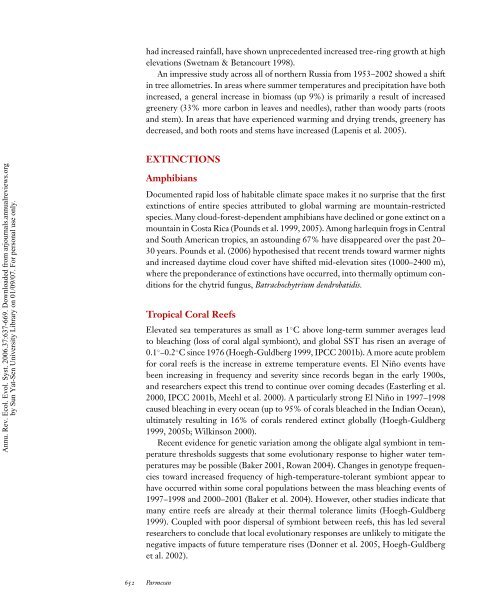Ecological and Evolutionary Responses to Recent Climate Change
Ecological and Evolutionary Responses to Recent Climate Change
Ecological and Evolutionary Responses to Recent Climate Change
You also want an ePaper? Increase the reach of your titles
YUMPU automatically turns print PDFs into web optimized ePapers that Google loves.
had increased rainfall, have shown unprecedented increased tree-ring growth at high<br />
elevations (Swetnam & Betancourt 1998).<br />
An impressive study across all of northern Russia from 1953–2002 showed a shift<br />
in tree allometries. In areas where summer temperatures <strong>and</strong> precipitation have both<br />
increased, a general increase in biomass (up 9%) is primarily a result of increased<br />
greenery (33% more carbon in leaves <strong>and</strong> needles), rather than woody parts (roots<br />
<strong>and</strong> stem). In areas that have experienced warming <strong>and</strong> drying trends, greenery has<br />
decreased, <strong>and</strong> both roots <strong>and</strong> stems have increased (Lapenis et al. 2005).<br />
Annu. Rev. Ecol. Evol. Syst. 2006.37:637-669. Downloaded from arjournals.annualreviews.org<br />
by Sun Yat-Sen University Library on 01/09/07. For personal use only.<br />
EXTINCTIONS<br />
Amphibians<br />
Documented rapid loss of habitable climate space makes it no surprise that the first<br />
extinctions of entire species attributed <strong>to</strong> global warming are mountain-restricted<br />
species. Many cloud-forest-dependent amphibians have declined or gone extinct on a<br />
mountain in Costa Rica (Pounds et al. 1999, 2005). Among harlequin frogs in Central<br />
<strong>and</strong> South American tropics, an as<strong>to</strong>unding 67% have disappeared over the past 20–<br />
30 years. Pounds et al. (2006) hypothesised that recent trends <strong>to</strong>ward warmer nights<br />
<strong>and</strong> increased daytime cloud cover have shifted mid-elevation sites (1000–2400 m),<br />
where the preponderance of extinctions have occurred, in<strong>to</strong> thermally optimum conditions<br />
for the chytrid fungus, Batrachochytrium dendrobatidis.<br />
Tropical Coral Reefs<br />
Elevated sea temperatures as small as 1 ◦ C above long-term summer averages lead<br />
<strong>to</strong> bleaching (loss of coral algal symbiont), <strong>and</strong> global SST has risen an average of<br />
0.1 ◦ –0.2 ◦ C since 1976 (Hoegh-Guldberg 1999, IPCC 2001b). A more acute problem<br />
for coral reefs is the increase in extreme temperature events. El Niño events have<br />
been increasing in frequency <strong>and</strong> severity since records began in the early 1900s,<br />
<strong>and</strong> researchers expect this trend <strong>to</strong> continue over coming decades (Easterling et al.<br />
2000, IPCC 2001b, Meehl et al. 2000). A particularly strong El Niño in 1997–1998<br />
caused bleaching in every ocean (up <strong>to</strong> 95% of corals bleached in the Indian Ocean),<br />
ultimately resulting in 16% of corals rendered extinct globally (Hoegh-Guldberg<br />
1999, 2005b; Wilkinson 2000).<br />
<strong>Recent</strong> evidence for genetic variation among the obligate algal symbiont in temperature<br />
thresholds suggests that some evolutionary response <strong>to</strong> higher water temperatures<br />
may be possible (Baker 2001, Rowan 2004). <strong>Change</strong>s in genotype frequencies<br />
<strong>to</strong>ward increased frequency of high-temperature-<strong>to</strong>lerant symbiont appear <strong>to</strong><br />
have occurred within some coral populations between the mass bleaching events of<br />
1997–1998 <strong>and</strong> 2000–2001 (Baker et al. 2004). However, other studies indicate that<br />
many entire reefs are already at their thermal <strong>to</strong>lerance limits (Hoegh-Guldberg<br />
1999). Coupled with poor dispersal of symbiont between reefs, this has led several<br />
researchers <strong>to</strong> conclude that local evolutionary responses are unlikely <strong>to</strong> mitigate the<br />
negative impacts of future temperature rises (Donner et al. 2005, Hoegh-Guldberg<br />
et al. 2002).<br />
652 Parmesan
















